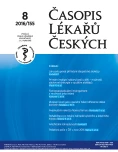How to treat an idiopatic scoliosis
Authors:
Petr Korbelář
Authors‘ workplace:
Ortopedická klinika dětí a dospělých 2. LF UK a FN Motol
Published in:
Čas. Lék. čes. 2016; 155: 398-405
Category:
Review Articles
Overview
Scoliosis is a three-dimensional deformity of the spine. In its most common form idiopathic scoliosis (70 to 80 % of cases), the causes are unknown. It is defined as a curve of at least 10°, measured on a standing radiograph using the Cobb technique. A severe form of scoliosis is more commonly found in females. Typically scoliosis does not cause any health problems during growth (except for extreme cases). Patients are generally treated in an attempt to halt the progressive nature of the deformity. We present a treatment of different kind of curves.
By the end of growth, the risk of health and social problems in adulthood increases significantly. Problems include reduced quality of life, disability, pain, increased cosmetic deformity, functional limitations, sometimes pulmonary problems, and progression during adulthood. It is necessary to start with the treatment ASAP, because the management of scoliosis includes the prevention of secondary problems associated with the deformity.
Keywords:
scoliosis, brace treatment, surgery treatment
Sources
1. Korbel K, Kozinoga M, Stoliński L, Kotwicki T. Scoliosis Research Society (SRS) Criteria and Society of Scoliosis Orthopaedic and Rehabilitation Treatment (SOSORT) 2008 guidelines in non-operative treatment of idiopathic scoliosis. Pol Orthop Traumatol 2014; 79: 118−122.
2. Rowe DE. The Scoliosis Research Society Brace Manual. Introduction. In: Manual of Brace Treatment for Idiopathic Scoliosis, Scoliosis Research Society, 2003.
3. Cobb J. Spine arthrodesis in treatment of scoliosis. Bull Hosp Joint Dis 1958; 29: 87−109.
4. Lenke LG, Betz RR, Clements D. Curve prevalence of a new classification of operative adolescent idiopathic scoliosis: does classification correlate with treatment? Spine 2002; 27: 604−601.
5. Hadra BE. Wiring the interspinosous processes in Pott’s disease. Trans Am Orthop Assoc 1891; 4: 206−210.
6. Hibbs RA. An operation for progressive spinal deformities. NY Med J 1911: 93−113.
7. Dwyer AF, Schafer MF. Anterior approach to scoliosis: reset of treatment in fifty-one cases. J Bone Joint Surg 1974; 56B: 218−224.
8. Zielke K, Stunkat R, Beujean F. Ventrale derotations-spondylodesis. Arch Orthop Unfallchir 1976: 85: 257−277.
Labels
Addictology Allergology and clinical immunology Angiology Audiology Clinical biochemistry Dermatology & STDs Paediatric gastroenterology Paediatric surgery Paediatric cardiology Paediatric neurology Paediatric ENT Paediatric psychiatry Paediatric rheumatology Diabetology Pharmacy Vascular surgery Pain managementArticle was published in
Journal of Czech Physicians

Most read in this issue
- Avascular necrosis of the femoral head
- Femoroacetabular impingement − treatment options
- Rehabilitation after total knee and hip arthroplasty
- Limb shortening in the management of leg length discrepancy
